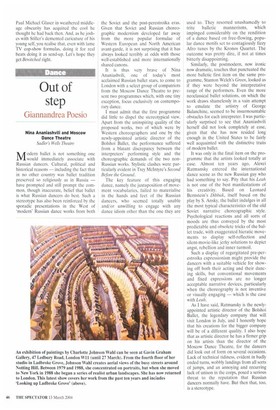Out of step
Giannandre a Poesio
Nina Ananiashvili and Moscow Dance Theatre Sadler's Wells Theatre
odern ballet is not something one would immediately associate with Russian dancers. Cultural, political and historical reasons — including the fact that in no other country was ballet tradition preserved so religiously as in Russia — have prompted and still prompt the common, though inaccurate, belief that ballet is what Russian dancers do best. Such a stereotype has also been reinforced by the sporadic presentations in the West of 'modern' Russian dance works from both the Soviet and the post-perestroika eras. Given that Soviet and Russian choreographic modernism developed far away from the more popular formulae of Western European and North American avant-garde, it is not surprising that it has always looked terribly at odds with those well-established and more internationally shared canons.
It is thus very brave of Nina Ananiashvili, one of today's most acclaimed Russian ballet stars, to come to London with a select group of compatriots from the Moscow Dance Theatre to present two programmes which, with one tiny exception, focus exclusively on contemporary dance.
I must admit that the first programme did little to dispel the stereotypical view. Apart from the uninspiring quality of the proposed works, two of which were by Western choreographers and one by the newly-appointed artistic director of the Bolshoi Ballet, the performance suffered from a blatant discrepancy between the interpreters' performing style and the choreographic demands of the two nonRussian works. Stylistic clashes were particularly evident in Trey McIntyre's Second Before the Ground.
The key feature of this engaging dance, namely the juxtaposition of movement vocabularies, failed to materialise in the hands and feet of the Russian dancers, who seemed totally unable and/or unwilling to engage with any dance idiom other than the one they are used to. They resorted unashamedly to trite balletic mannerisms, which impinged considerably on the rendition of a dance based on free-flowing, popular dance motifs set to contagiously fizzy Afro tunes by the Kronos Quartet. The outcome was pretty dire, if not at times bitterly disappointing.
Similarly, the postmodern, now ironic now dramatic, touches that punctuated the more balletic first item on the same programme, Stanton Welch's Green, looked as if they were beyond the interpretative range of the performers. Even the more neoclassical ballet solutions, on which the work draws shamelessly in a vain attempt to emulate the artistry of George Balanchine, seemed to be insurmountable obstacles for each interpreter. I was particularly surprised to see that Ananiashvili herself did not look completely at ease, given that she has now resided long enough in the United States to be fairly well acquainted with the distinctive traits of modern ballet.
It was only in the final item on the programme that the artists looked totally at ease. Almost ten years ago, Alexei Ratmansky entered the international dance scene as the new Russian guy who had something to say. Pity that his Leah is not one of the best manifestations of his creativity. Based on Leonard Bernstein's Dibbuk, itself based on the play by S. Ansky, the ballet indulges in all the most typical characteristics of the old Soviet narrative choreographic style. Psychological reactions and all sorts of moods are thus conveyed by the most predictable and obsolete tricks of the ballet trade, with exaggerated hieratic movements to display self-reflection and silent-movie-like jerky solutions to depict angst, rebellion and inner turmoil.
Such a display of regurgitated pre-perestroika expressionism might provide the dancers with a suitable vehicle for showing off both their acting and their dancing skills, but conventional movements and fixed expressions are no longer acceptable narrative devices, particularly when the choreography is not inventive or visually engaging — which is the case with Leah.
As I have said, Ratmansky is the newlyappointed artistic director of the Bolshoi Ballet, the legendary company that will visit London in July, and I honestly hope that his creations for the bigger company will be of a different quality. I also hope that as artistic director he has a firmer grip on his artists than the director of the Moscow Dance Theatre, for the dancers did look out of form on several occasions. Lack of technical tidiness, evident in badly ended turns, wobbly landings from all sorts of jumps, and an annoying and recurring lack of unison in the corps, posed a serious threat to the reputation that Russian dancers normally have. But then that, too, is a stereotype.


































































 Previous page
Previous page